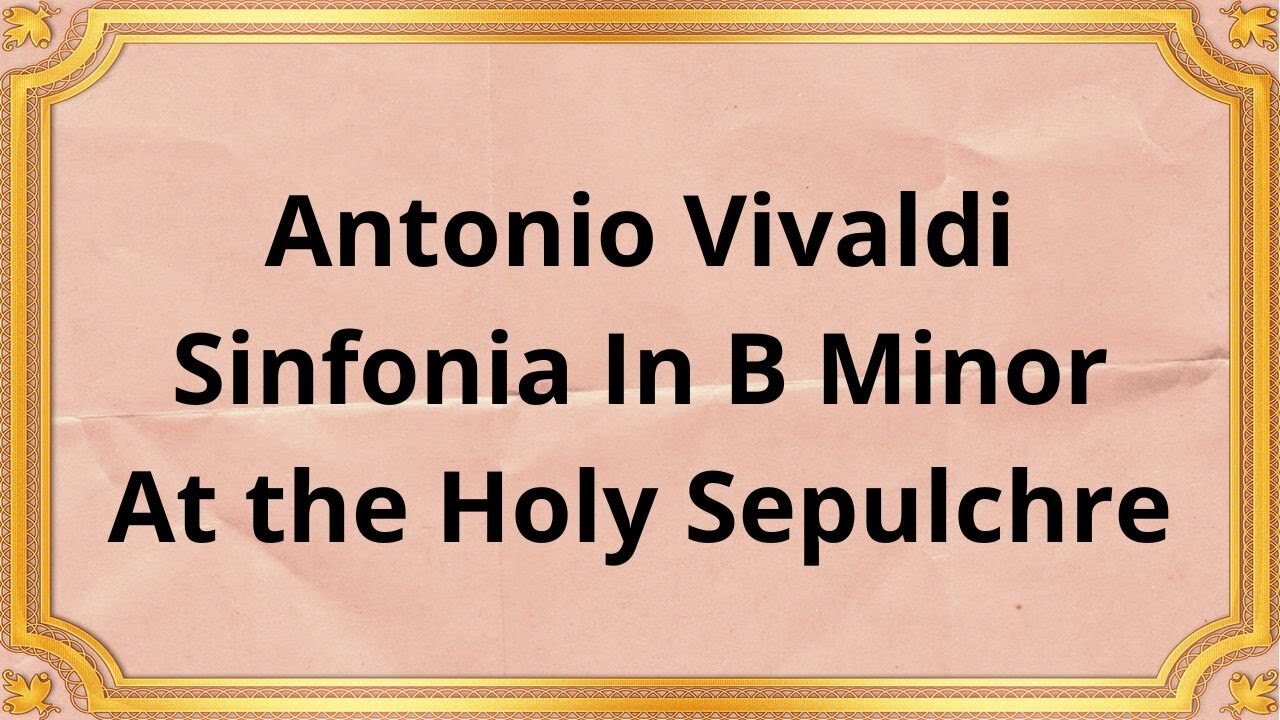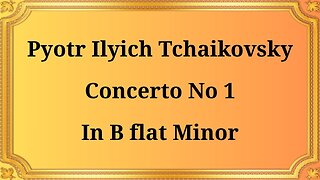Premium Only Content

Antonio Vivaldi Sinfonia In B Minor At the Holy Sepulchre
#AntonioVivaldi #ClassicalMusic #SinfoniaInBMinor #HolySepulchre #BaroqueComposer #MusicComposition #ItalianComposer #Orchestra #ClassicalInstruments #MusicalMasterpiece
Orchestra "Alessandro Scarlatti" of Naples of the RAI;
conducted Thomas Schippers
Antonio Vivaldi, an influential Italian composer of the Baroque era, has left an indelible mark on the world of classical music. One of his lesser-known yet remarkable compositions is the "Sinfonia In B Minor At the Holy Sepulchre."
The "Sinfonia In B Minor At the Holy Sepulchre" was composed by Antonio Vivaldi in the early 18th century. During this time, Vivaldi served as the maestro di violino at the Ospedale della Pietà, a renowned music school and orphanage in Venice. The composition of this sinfonia coincided with Vivaldi's prolific period, during which he composed numerous concertos, sonatas, and sacred works.
The sinfonia is structured in three movements, adhering to the traditional fast-slow-fast sequence typical of Baroque instrumental compositions. It begins with a lively and energetic Allegro, showcasing Vivaldi's mastery of counterpoint and intricate melodic lines. The second movement, marked Adagio, offers a moment of tranquility with its gentle and expressive melodies. Finally, the sinfonia concludes with a spirited Allegro, characterized by virtuosic passages and vibrant orchestration.
The instrumentation of the sinfonia showcases Vivaldi's affinity for orchestral writing. It typically employs a string orchestra accompanied by a continuo, consisting of harpsichord and cello. The interplay between the different sections of the orchestra creates a rich tapestry of sound, with each instrument adding its unique voice to the composition.
The "Sinfonia In B Minor At the Holy Sepulchre" holds historical and cultural significance. It was primarily composed for performance during religious ceremonies at the Holy Sepulchre, a significant site in Jerusalem associated with the crucifixion and burial of Jesus Christ. This connection to sacred spaces adds a spiritual dimension to the composition, heightening its emotional impact.
Furthermore, this sinfonia exemplifies Vivaldi's innovative approach to composition. His use of contrasting dynamics, bold harmonies, and intricate ornamentation showcases his unrivaled skill as a composer. The sinfonia's blend of technical virtuosity and expressive melodies captivates listeners, making it a valuable addition to the repertoire of Baroque music.
Conclusion:
Antonio Vivaldi's "Sinfonia In B Minor At the Holy Sepulchre" stands as a testament to the composer's genius and mastery of the Baroque style. Its historical significance, musical elements, and emotional depth make it a truly remarkable piece of music. Through this sinfonia, Vivaldi's legacy continues to resonate, captivating audiences and reminding us of the enduring power of classical music.
You have the opportunity to support the channel:
https://destream.net/live/RadSiarAl/donate
https://www.buymeacoffee.com/6355radsiaral
-
 31:06
31:06
Classical music_Music Inspiration
1 month agoPyotr Ilyich Tchaikovsky Piano Concerto No. 1 in B-flat minor
571 -
 LIVE
LIVE
LFA TV
10 hours agoLFA TV ALL DAY STREAM - THURSDAY 9/4/25
1,310 watching -
 13:43
13:43
The Kevin Trudeau Show Limitless
1 day agoClassified File 3 | Kevin Trudeau EXPOSES Secret Society Brainwave Training
72.8K10 -
 1:09:23
1:09:23
The HotSeat
2 hours agoTrump’s Parade = Mocked, China’s Parade = Praised: Leftist Hypocrisy EXPOSED
14.4K3 -
 1:57:29
1:57:29
The Quartering
4 hours agoRFK Jr Goes NUCLEAR, Horrible Tomb Raider News, Anti-White Male Propaganda
95K32 -
 LIVE
LIVE
Dr Disrespect
6 hours ago🔴LIVE: Hell Is Us Launch - DR DISRESPECT’s First Look at the Scariest Game of 2025!
1,043 watching -
 11:17
11:17
Dr. Nick Zyrowski
29 days agoTop 10 No CARB No SUGAR Foods That Will Change Your Health
30.4K4 -
 LIVE
LIVE
Chrissie Mayr
2 days agoChrissie Mayr's Content Hotel at The Villa Roma! Anthony Cumia, Dave Landau, Violet
57 watching -
![[Ep 741] RFK Jr. Hits Back at Rabid Dems | Portland Antifa Terrorists | The Evil That is the Left](https://1a-1791.com/video/fww1/bb/s8/1/W/U/c/f/WUcfz.0kob-small-Ep-741-RFK-Jr.-Hits-Back-at.jpg) LIVE
LIVE
The Nunn Report - w/ Dan Nunn
2 hours ago[Ep 741] RFK Jr. Hits Back at Rabid Dems | Portland Antifa Terrorists | The Evil That is the Left
169 watching -
 1:52:45
1:52:45
John Burk
4 hours agoThe Texas Hemp ban, DOJ removing guns from trans, and more.
16.7K3